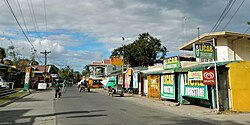This article needs additional citations for verification .(October 2012) |
Licab | |
|---|---|
| Municipality of Licab | |
(From top, left to right): Licab Municipal Hall building, Our Lady of the Holy Rosary Parish, Liwasang Dalmacio, Saint Christopher Academy, Old Town Center Welcome Sign, Downtown area | |
 Map of Nueva Ecija with Licab highlighted | |
 Interactive map of Licab | |
Location within the Philippines | |
| Coordinates: 15°32′24″N120°45′43″E / 15.54°N 120.7619°E | |
| Country | Philippines |
| Region | Central Luzon |
| Province | Nueva Ecija |
| District | 1st district |
| Barangays | 11 (see Barangays) |
| Government | |
| • Type | Sangguniang Bayan |
| • Mayor | Eufemia D. Domingo |
| • Vice Mayor | Albert M. Caraang |
| • Representative | Estrellita B. Suansing |
| • Municipal Council | Members |
| • Electorate | 18,034 voters (2025) |
| Area | |
• Total | 67.37 km2 (26.01 sq mi) |
| Elevation | 24 m (79 ft) |
| Highest elevation | 38 m (125 ft) |
| Lowest elevation | 17 m (56 ft) |
| Population (2024 census) [3] | |
• Total | 29,590 |
| • Density | 439.2/km2 (1,138/sq mi) |
| • Households | 7,312 |
| Economy | |
| • Income class | 4th municipal income class |
| • Poverty incidence | 11.72 |
| • Revenue | ₱ 154.3 million (2022) |
| • Assets | ₱ 266.3 million (2022) |
| • Expenditure | ₱ 142.6 million (2022) |
| • Liabilities | ₱ 65.23 million (2022) |
| Service provider | |
| • Electricity | Nueva Ecija 2 Area 1 Electric Cooperative (NEECO 2 A1) |
| Time zone | UTC+8 (PST) |
| ZIP code | 3112 |
| PSGC | |
| IDD : area code | +63 (0)44 |
| Native languages | Tagalog Ilocano |
Licab, officially the Municipality of Licab (Tagalog : Bayan ng Licab; Ilocano : Ili ti Licab; Pangasinan : Baley na Licab), is a municipality in the province of Nueva Ecija, Philippines. According to the 2024 census, it has a population of 29,590 people. [5]








